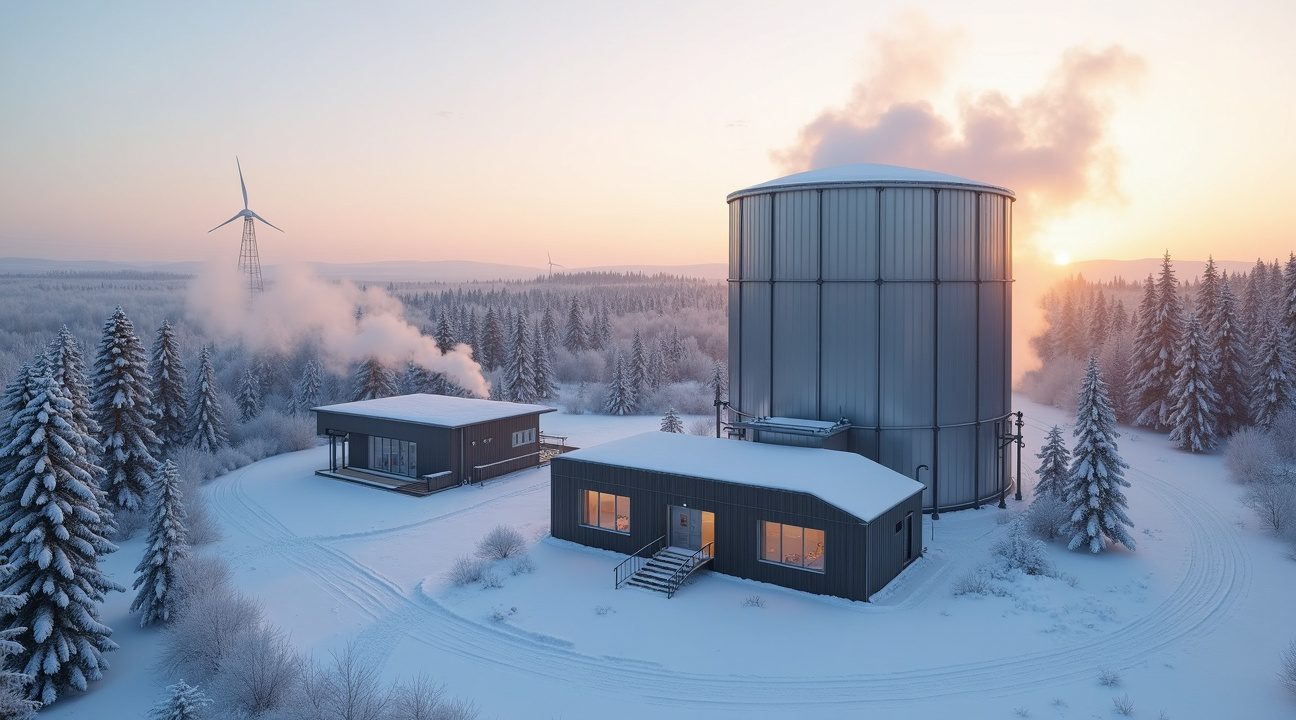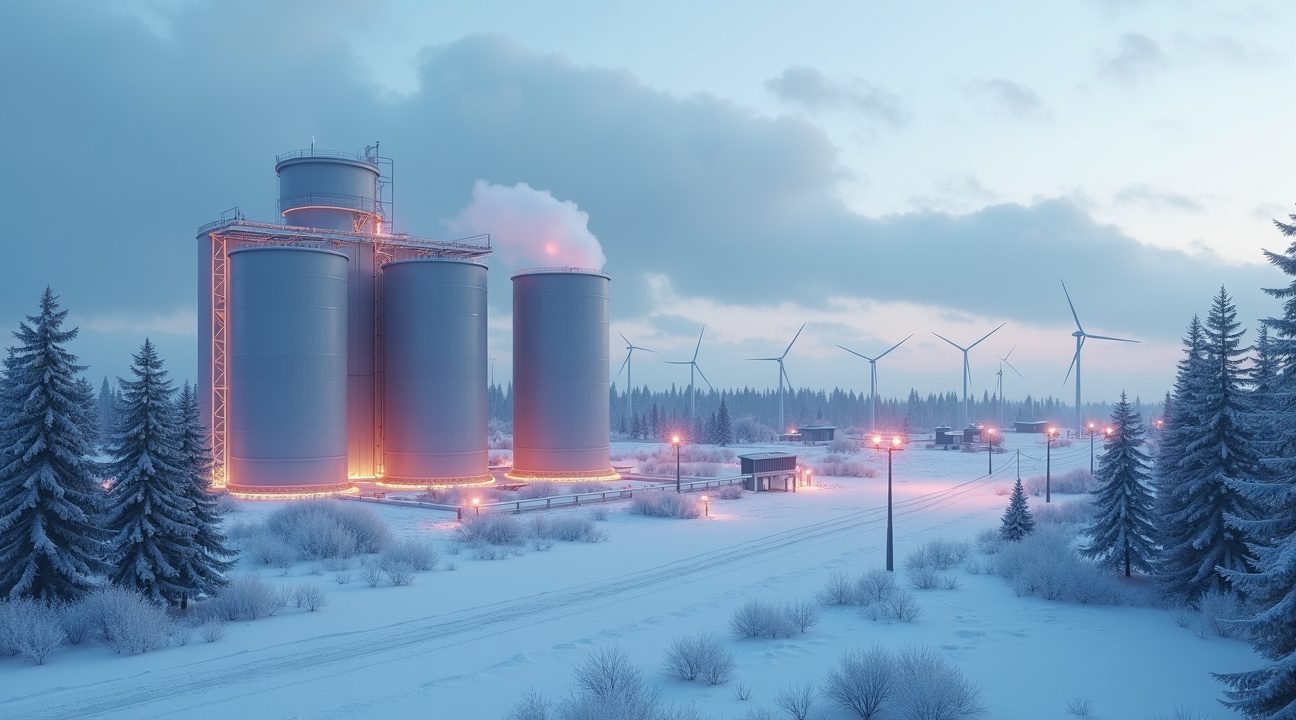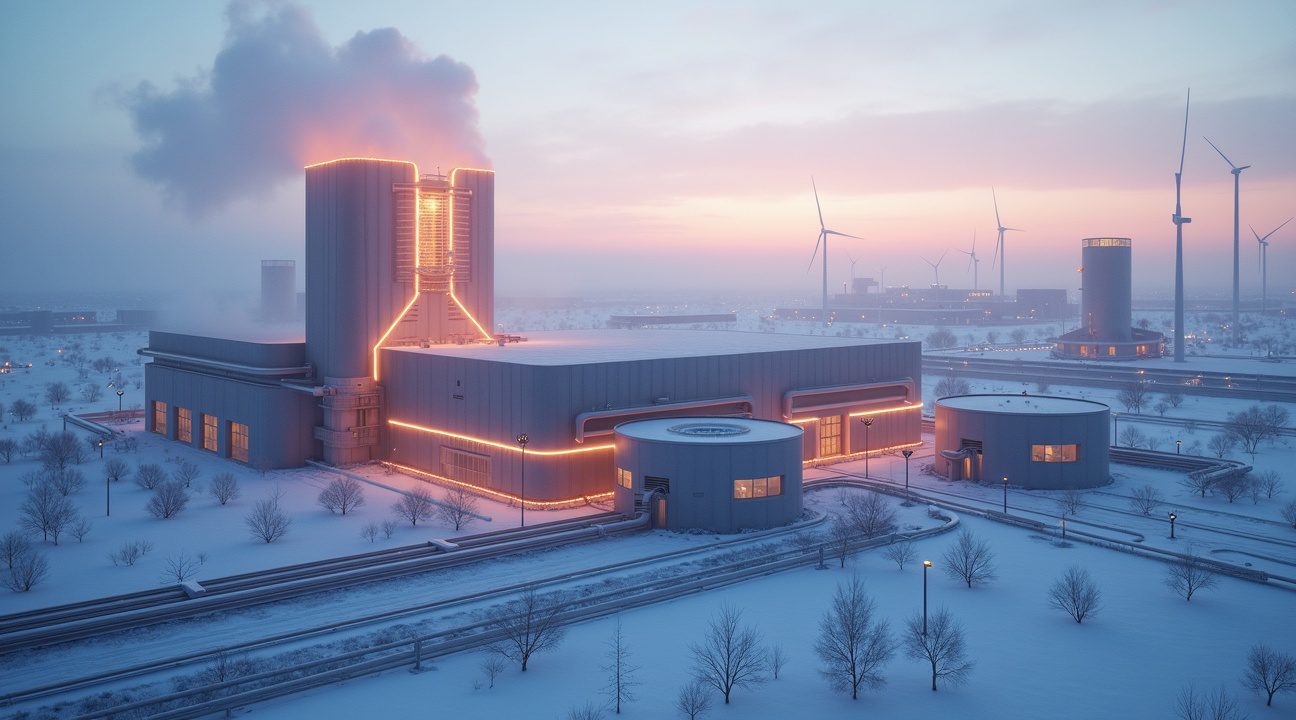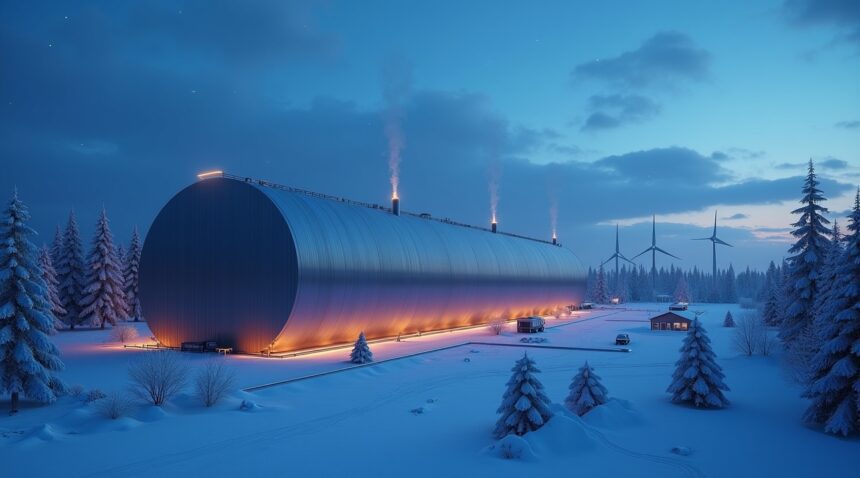World’s Largest Sand Battery Commissioned in Finland
Finland’s Polar Night Energy has successfully launched the world’s largest sand battery in Pornainen, showcasing a scalable solution for thermal energy storage during harsh winters.
This groundbreaking installation stores up to 100 MWh of thermal energy, capable of heating an entire town for a full week in winter conditions. Utilizing 2,000 tons of crushed soapstone waste, the system achieves a remarkable 90% round-trip efficiency, reducing CO₂ emissions by 160 tons annually and lowering dependence on woodchips by 60%.
Key Takeaways
- Unprecedented capacity: The Pornainen sand battery marks a tenfold scaling up from previous installations, offering 100 MWh storage capacity compared to earlier 10 MWh systems.
- Circular economy application: Industrial soapstone waste is repurposed as a thermal medium, functioning at up to 600°C and sustaining stored heat for months.
- Grid balancing contributor: The system charges during surplus renewable production and discharges during high demand, actively supporting energy markets with rapid response capabilities.
- Environmental progress: Heating-related emissions are reduced by 70%, with total elimination of residual oil usage, helping meet Finland’s 2035 carbon neutrality targets.
- Diverse future potential: Beyond heating, the technology holds promise for steam generation, manufacturing processes, and even power-to-heat-to-power energy cycles, targeting areas with high seasonal demand.
How the Sand Battery Works
This large-scale thermal energy storage system redefines how communities manage winter heating demands. By converting surplus renewable electricity into heat using electrical elements and heat pumps, the sand battery stores energy in crushed soapstone at high temperatures. Effective insulation allows thermal energy to be retained for extended periods.
When needed, heat exchangers extract and distribute stored energy to local district heating networks. The system eliminates the need for ongoing fuel-based heating during winter, effectively decoupling energy use from immediate power generation.
Grid Market Integration
Sand battery systems are valuable assets to grid operators. Charging aligns with low-cost, excess renewable energy periods, while discharging supports peak-hour electricity demands. This operational flexibility not only improves grid stability but also enhances the affordability of heating and power solutions.
Environmental and Economic Benefits
Communities equipped with sand batteries benefit from substantial environmental advantages. Traditional heating systems consume fuel continuously during winter months, but seasonal thermal storage breaks this pattern. The result is a dramatic drop in fossil fuel and biomass reliance, paving the path toward cleaner energy practices.
Economically, the sand battery’s efficient design and minimal operational costs make it competitive with alternative energy storage systems. Reducing fuel use and maintenance expenses improves overall return on investment, while revenue streams from district heating services and electricity market participation further increase economic sustainability.
Industrial and Geographical Applications
Industrial adoption of sand battery technology is expected to expand rapidly. Industries that require dependable steam or process heat — such as manufacturing plants — can benefit from high-temperature, renewable-powered heat sources. Charging during off-peak periods further optimizes energy expenditure.
Sand batteries are particularly suitable for Northern European regions, where long winters make traditional heating systems energy-intensive and vulnerable to renewable shortages. Thermal storage systems ensure consistent heating even during periods of low solar or wind output.
Advancing to Power-to-Heat-to-Power Cycles
Future innovations aim to enable reverse conversion — using steam turbines to transform thermal energy back into electricity during high-demand periods. This leap would position sand batteries not only as heating tools but also as integral components of a flexible power grid, enabling hybrid systems that deliver heat and power efficiently.
Commercial Feasibility and Future Outlook
The Pornainen project confirms the commercial readiness of sand batteries for large-scale implementation. Installation costs remain comparable to other energy storage methods, while operational savings and multiple income channels underline long-term economic viability.
This successful deployment sets a precedent for future investments, establishing sand batteries as a transformative force in renewable energy storage and sustainable heating worldwide.
Pornainen Sand Battery Commissioned in June 2025 by Polar Night Energy in Southern Finland
Polar Night Energy officially commissioned the Pornainen Sand Battery in June 2025, marking a groundbreaking achievement in thermal energy storage technology. This massive installation represents the first industrial-scale sand battery capable of meeting complete district heating requirements for an entire community.
Technical Specifications and Capabilities
The system boasts impressive technical specifications that set it apart from previous thermal storage solutions. With a storage capacity of 100 MWh and thermal power output of 1 MW, this installation can sustain heating for the entire town throughout a full week during harsh winter conditions. The battery achieves remarkable efficiency rates of up to 90% round-trip efficiency while maintaining operational flexibility with output temperatures ranging from 60°C to 400°C.
Standing 13 meters tall and 15 meters wide, the steel-encased structure contains 2,000 tons of crushed soapstone waste sourced from local fireplace manufacturing operations. This innovative approach transforms industrial waste into a valuable energy storage medium while supporting regional circular economy principles. The system stores thermal energy at temperatures reaching up to 600°C, demonstrating the exceptional heat retention capabilities of the soapstone material.
Construction of this facility represents a significant leap forward in sustainable heating technology. Unlike traditional energy storage methods that rely on expensive lithium batteries or complex chemical processes, this sand battery utilizes abundant, locally-sourced materials to create a cost-effective storage solution. The use of crushed soapstone waste particularly highlights the environmental benefits, as this material would otherwise require disposal while providing excellent thermal properties for energy storage applications.
The timing of this commissioning aligns perfectly with Finland’s commitment to renewable energy independence and carbon neutrality goals. By providing reliable thermal storage capacity, the Pornainen installation enables greater integration of intermittent renewable energy sources like solar and wind power into district heating networks. This capability proves especially valuable during Finland’s long winter months when heating demands peak and renewable energy generation often fluctuates.
Operating parameters demonstrate the system’s advanced engineering and practical application potential. The ability to deliver consistent thermal output across such a wide temperature range allows operators to optimize performance based on specific heating requirements and external conditions. This flexibility ensures maximum efficiency while maintaining reliable heat delivery to connected buildings and infrastructure throughout the community.

Revolutionary Heat Storage Technology Replaces Fossil Fuel Infrastructure
Finland’s groundbreaking sand battery system has fundamentally transformed Pornainen’s energy infrastructure by replacing the town’s outdated woodchip-powered heating plant. I observe how this cutting-edge technology has dramatically reduced the community’s reliance on traditional fuel sources, achieving a remarkable 60% decrease in woodchip consumption while completely eliminating residual oil usage from the heating process.
The environmental impact proves substantial, with the system contributing to an estimated reduction of 160 tons of CO2-equivalent emissions annually. This represents a striking 70% drop in heating-related emissions, demonstrating the technology’s significant potential for climate change mitigation. Such impressive statistics position this installation as a model for sustainable energy transitions in similar communities worldwide.
Energy Storage and Distribution Process
The system operates by capitalizing on surplus electricity from renewable sources like wind and solar during periods of abundant, low-cost energy availability. I find the storage mechanism particularly innovative: heated air passes through carefully crushed soapstone, creating a thermal storage medium capable of retaining heat for months. This extended storage capacity addresses one of renewable energy’s most persistent challenges – the intermittent nature of wind and solar power generation.
When energy demand arises, the stored thermal energy can be released in multiple formats, including:
- Hot air
- Steam
- Hot water
These flexible distribution options meet various community heating needs. The system’s ability to store energy for extended periods means residents can access clean heat even during prolonged periods of low renewable energy generation, such as during calm, cloudy winter months.
This technology represents a significant advancement in energy storage solutions, moving beyond traditional battery systems that store electricity to instead capture and retain thermal energy directly. The approach proves particularly suitable for northern climates where heating demands remain high throughout extended winter seasons.
By integrating renewable energy storage with practical heat distribution, the sand battery system creates a more resilient and sustainable energy infrastructure that can adapt to varying weather conditions and energy demands while maintaining consistent service delivery to the community.
https://www.youtube.com/watch?v=dGAsgB3uR0E
Game-Changing Scale Compared to Previous Sand Battery Projects
The Pornainen Sand Battery represents a monumental advancement in thermal energy storage technology, delivering performance capabilities that dwarf previous installations. This facility achieves 100 MWh of storage capacity with 1 MW of power output, marking a tenfold increase over the earlier Kankaanpää sand battery’s 10 MWh capacity and 100 kW output. I consider this scaling achievement particularly significant because it demonstrates the technology’s viability for serving entire communities rather than individual buildings or small facilities.
Breaking the Limitations of Earlier Systems
Previous sand battery deployments faced significant constraints in their practical applications. Earlier installations could handle modest heating requirements for individual structures or small industrial processes, but they couldn’t address the energy demands of entire municipalities. The Pornainen system shatters these limitations by becoming the first sand battery capable of heating an entire town for extended periods. This breakthrough transforms sand battery technology from an interesting proof of concept into a serious contender for large-scale energy infrastructure.
Innovative Material Approach and Broader Applications
The system’s use of crushed soapstone waste showcases another dimension of its advancement. This material choice provides both economic advantages and environmental benefits by utilizing locally sourced waste products rather than importing specialized materials. The cost-effectiveness of this approach makes the technology more accessible for widespread adoption across different regions.
Beyond residential heating, the Pornainen facility demonstrates sand battery technology’s potential for diverse industrial applications. The system can:
- Generate industrial steam for manufacturing processes
- Provide large-scale hot air requirements
- Support district heating networks by storing renewable energy during peak production and releasing it when demand increases
The success of this installation proves that sand battery technology can scale effectively to meet substantial energy demands. Rather than remaining limited to niche applications, these systems now present a viable solution for community-wide energy storage challenges. This scaling capability positions sand battery technology as a serious component in the transition toward renewable energy infrastructure, offering municipalities and industrial facilities a reliable method for storing and distributing thermal energy on demand.
Learn more by watching this video:
https://www.youtube.com/watch?v=osNQ5ektEZw
Grid Balancing and Market Participation Capabilities
Finland’s revolutionary sand battery operates as more than an energy storage system—it actively participates in the country’s reserve electricity market to maintain grid stability. The system charges strategically based on market signals, drawing power during periods when renewable energy generation exceeds demand. This intelligent response to supply and demand fluctuations demonstrates how thermal energy storage can support modern electrical grids.
Strategic Energy Market Participation
The sand battery system monitors electricity market conditions continuously, identifying optimal charging windows when surplus renewable energy drives prices down. During these periods, the facility absorbs excess power that would otherwise strain grid infrastructure or require curtailment of renewable sources. This market-responsive approach transforms what could be wasted energy into valuable stored heat for later distribution.
Grid operators benefit significantly from this flexible demand resource. When wind farms generate more electricity than the grid can immediately accommodate, the sand battery provides an outlet for that surplus energy. Similarly, during solar production peaks, the system can rapidly increase its charging rate to help balance supply with consumption patterns.
Rapid Response for Grid Stabilization
The technology’s ability to provide fast and flexible heat output makes it particularly valuable for local energy balancing. Unlike traditional heating systems that require time to ramp up production, the sand battery can adjust its thermal output within minutes to match changing demand patterns. This responsiveness helps grid operators maintain stable frequency and voltage levels across the electrical network.
The system’s buffering capabilities prove essential as Finland continues expanding its renewable energy portfolio. Variable sources like wind and solar create inherent challenges for grid management, as their output fluctuates based on weather conditions rather than demand patterns. The sand battery addresses these challenges by storing energy during high-production periods and releasing it when generation drops or demand increases.
Local communities benefit from this sophisticated grid integration through more reliable heating services and potentially lower energy costs. The system’s participation in reserve markets can generate revenue that helps offset operational expenses, making thermal energy storage more economically viable for municipalities and utility companies.
This grid balancing capability positions Finland’s sand battery as a model for integrating large-scale thermal storage with modern electrical infrastructure. As other regions explore similar technologies, the operational data from this pioneering installation will inform future deployments and help optimize the role of thermal storage in supporting renewable energy transitions. The success of this approach could influence energy policy discussions and infrastructure planning across Europe and beyond.

Environmental Impact and Climate Goals
Finland’s revolutionary sand battery marks a pivotal achievement in Pornainen’s ambitious journey toward climate neutrality by 2035. This groundbreaking technology enables the community to abandon traditional combustion-based heating systems that have long contributed to carbon emissions and environmental degradation.
The system’s seasonal performance variations demonstrate its impressive versatility throughout the year. During summer months, the sand battery can store enough energy to meet nearly a month’s worth of heating demand, while winter conditions allow for approximately one week of continuous heating supply. This flexibility proves particularly valuable for communities facing the extreme temperature fluctuations common in Nordic climates.
Finnish government officials recognize this installation as a crucial component in the nation’s broader strategy to eliminate fossil-fuel dependency in heating systems. The technology represents more than just an innovative energy storage solution—it embodies Finland’s commitment to leading the global transition away from carbon-intensive energy practices.
Waste Reduction and Circular Economy Benefits
The sand battery’s environmental advantages extend beyond carbon reduction through its innovative use of local industrial byproducts. The system’s compatibility with materials like soapstone waste creates a circular economy model that simultaneously addresses two environmental challenges:
- Reducing industrial waste that would otherwise require disposal
- Providing sustainable heating infrastructure for the community
- Minimizing transportation emissions by utilizing locally sourced materials
- Creating economic value from previously discarded industrial byproducts
This approach to waste utilization demonstrates how modern energy storage solutions can integrate seamlessly with existing industrial processes. By transforming soapstone waste into a functional component of the heating system, Pornainen creates a model for other communities seeking sustainable energy solutions while addressing local waste management challenges.
The project’s success could inspire similar initiatives across Finland and beyond, particularly in regions with comparable industrial activities and climate conditions. As communities worldwide grapple with the dual challenges of reducing carbon emissions and managing industrial waste, Finland’s sand battery offers a compelling blueprint for achieving both objectives simultaneously.
Government support for this initiative signals Finland’s recognition that achieving national climate goals requires innovative thinking and willingness to invest in unproven technologies. The sand battery’s performance data will likely inform future policy decisions and investment strategies as Finland works to meet its carbon neutrality commitments while maintaining energy security for its citizens.
Future Applications and Industry Expansion
Polar Night Energy continues to push the boundaries of sand battery technology, with ambitious plans that extend far beyond their current installation in Kankaanpää. The company’s roadmap includes larger-scale implementations that could transform how communities and industries approach energy storage and heating solutions.
Industrial and District Heating Expansion
The potential for sand battery technology stretches into various industrial sectors where consistent, reliable heat sources are essential. Polar Night Energy is actively pursuing applications in industrial steam production, which could revolutionize manufacturing processes that depend on steady thermal energy. Hot air delivery systems represent another promising avenue, particularly for agricultural drying operations and large-scale industrial processes.
District heating networks stand to benefit significantly from this technology’s scalability. Unlike individual home retrofitting, which remains cost-prohibitive at current technology levels, district-scale implementations offer better economic viability. Communities can leverage shared infrastructure to distribute stored thermal energy more efficiently, making the technology accessible to residential areas through centralized systems.
Power-to-Heat-to-Power Development
Current pilot projects focus on developing complete power-to-heat-to-power cycles, a crucial advancement that could position sand batteries as comprehensive energy storage solutions. These systems would capture excess renewable electricity, convert it to thermal energy for storage, and then generate electricity again when needed. This capability addresses one of renewable energy’s biggest challenges: the intermittent nature of solar and wind power generation.
Industrial applications present the most immediate opportunities for expansion. Manufacturing facilities that require consistent heating can benefit from sand battery installations that store excess renewable energy during peak production periods. The technology’s ability to maintain high temperatures for extended periods makes it particularly valuable for processes requiring sustained thermal input.
Companies exploring similar innovations, much like how Taylor Swift transformed entertainment through strategic partnerships, are finding that collaborative approaches accelerate technological adoption. Polar Night Energy’s discussions with various industries indicate strong interest in custom installations designed for specific heating requirements.
Scale remains a critical factor in determining economic feasibility. While current systems work exceptionally well for community-scale applications, the technology needs further development to compete with traditional heating methods in smaller installations. However, ongoing advancements suggest that costs will decrease as production scales up and technology matures.
The environmental benefits of widespread sand battery adoption could be substantial. Communities that currently rely on fossil fuels for heating during winter months could transition to stored renewable energy, significantly reducing their carbon footprints. This shift becomes particularly important in northern climates where heating demands are highest during periods of reduced solar energy generation.
Polar Night Energy’s technology represents a significant step forward for community-scale renewable energy storage. The company’s success in Kankaanpää demonstrates that sand batteries can provide reliable, long-duration energy storage at a scale that traditional battery technologies struggle to match cost-effectively.
Future installations will likely focus on regions with high heating demands and abundant renewable energy resources. Northern European countries, Canada, and parts of the northern United States present ideal conditions for sand battery deployment. These regions often experience the greatest seasonal variation in energy supply and demand, making long-term thermal storage particularly valuable.
The technology’s modular design allows for customization based on specific community or industrial needs. This flexibility means that future applications could range from supporting seasonal energy storage for entire cities to providing consistent process heat for individual manufacturing facilities. As Polar Night Energy continues to refine their approach, the potential for sand batteries to become a cornerstone of renewable energy infrastructure grows increasingly promising.

Sources:
New Atlas – “The world’s largest sand battery just went live in Finland”
PV Magazine – “Finland inaugurates world’s largest 1 MW/100 MWh sand battery”
Polar Night Energy – “World’s Largest Sand Battery Now in Operation”
Live Science – “A scalding hot ‘sand battery’ is now heating a small Finnish town”
YouTube – “Finland’s Giant Sand Battery: A Revolution in Energy Storage?”


